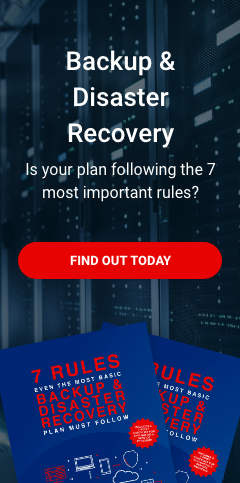With hurricane season quickly approaching, business owners need to start preparing their IT environments for potential disruptions. Hurricanes can cause a lot of damage, and if you're not well-prepared, your business could face a lot of downtime and data loss.
Here are some best practices to help keep your business safe and operational even if a hurricane hits your workplace.
1. Understand which and how much data you can afford to lose
Your business will not survive total data loss, but it can survive a minor data loss. For example, your business can stay operational even if you lose customer contact information or your archived files from several years ago, but it wouldn’t be able to function if it loses the latest data from critical apps.
This is why your organization needs to understand which and how much data you can afford to lose in the event of a hurricane. This information will help you determine which data you have to prioritize and what type of backup and disaster recovery plan (DRP) you need to put in place. Having a DRP will also help you set your recovery time objective (RTO) and recovery point objective (RPO).
2. Consider your RTO and RPO
RTO is the amount of downtime your business can take before your bottom line is impacted, while RPO is the amount of data that your business can lose before your operations are affected.
When determining your RTO and RPO, consider how much downtime your business can tolerate without losing a significant amount of money. If you operate a retail business, for instance, you may not be able to afford to experience downtime for more than a few hours at a time. If you run a manufacturing business, you may be able to tolerate a few days of downtime without too much impact. Determining your RTO and RPO allows you to put together a plan that ensures your business can meet those objectives.
3. Secure your backups
Invest in redundant systems, and make sure you have at least one offsite data backup location. This enables you to have multiple copies of critical data and applications stored in different places. That way, if one location is compromised during a hurricane, you can still access your data and applications from another backup site.
Be prepared for hardware failure, cyberattacks, and other catastrophes. Download our FREE eBook on backups and disaster recovery now!
4. Regularly test your DRP
It's critical to test DRPs regularly to ensure that your plan is effective and up-to-date at any given time. A well-tested DRP can also help you minimize the impact of a disruptive event and get your business back up and running quickly.
When testing your DRP, make sure you test all aspects of the plan, including data backup, system failover, and communication protocols. Involve key personnel in the testing process so they can get familiar with their roles and responsibilities in the event of a disaster.
Testing your DRP once a year should be enough, but more frequent testing may be necessary if you have made significant changes to your IT infrastructure.
5. Work with a managed IT services provider (MSP)
Partnering with a reliable MSP is critical to ensure continuity of operations during and after a hurricane. Your MSP partner can help you develop, improve, or implement your DRP, from backing up data to securing critical infrastructure to ensuring employees can work remotely if needed.
They can also provide 24/7 IT systems monitoring during a hurricane or other disaster. This way, you can be sure that your systems are always running smoothly and any issues are quickly addressed. Additionally, an MSP can help restore data, repair damage, and ensure all employees have the resources they need to work effectively.
By following these best practices, you can help keep your business safe during hurricane season. If you’re looking to partner with an MSP to help you weather any storm, look no further than Cutting Edge IT. Talk to our IT experts today to learn more about our comprehensive disaster recovery solutions.


Leave a comment!